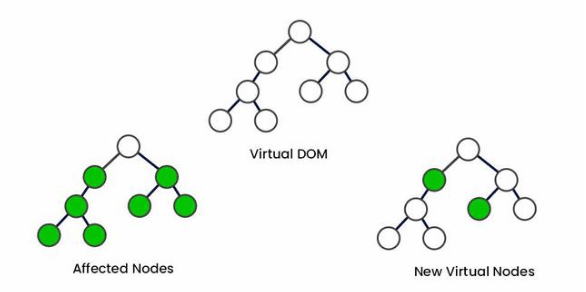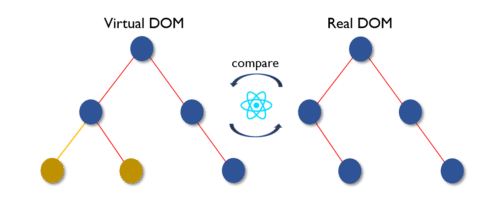
- What is DOM?
- What is Virtual DOM?
- How React Uses Virtual DOM
- Real DOM vs Virtual DOM
- Advantages of Virtual DOM
- How DOM Updates in React
- Reconciliation Process
- Conclusion
What is DOM?
The Document Object Model (DOM) is a crucial programming interface provided by web browsers that enables scripts, typically written in JavaScript, to dynamically access and manipulate the content, structure, and style of a webpage. When a browser loads a webpage, it parses the HTML and creates a live, in-memory representation of the document, known as the DOM in React. This model represents the structure of the page as a tree-like hierarchy of nodes. Each node corresponds to a part of the document such as elements, attributes (e.g., class, id), and text content. The DOM allows developers to programmatically navigate this tree, search for specific elements, and update or delete nodes, all of which are essential topics in Web Designing Training. For example, a script can change the text of a paragraph, update the style of a button, or dynamically add new elements like forms or images. This capability is essential for creating interactive and responsive user experiences on modern websites. Moreover, the DOM is event-driven, meaning it can detect and respond to user interactions such as clicks, key presses, or mouse movements. Event listeners can be attached to specific DOM nodes to trigger JavaScript functions in response to these interactions. Overall, the DOM serves as a bridge between HTML content and JavaScript functionality. It provides developers with a powerful toolset for transforming static web pages into dynamic, interactive applications. Understanding the DOM is fundamental for front-end web development, as it underlies nearly all client-side scripting and interaction.
To Earn Your Web Developer Certification, Gain Insights From Leading Data Science Experts And Advance Your Career With ACTE’s Web Developer Courses Today!
What is Virtual DOM?
The Virtual DOM is a lightweight, in-memory representation of the real DOM elements and is commonly used in modern web development frameworks like React. Unlike the real DOM, which is directly tied to the browser and can be slow to update, the Virtual DOM exists entirely as a JavaScript object. It mirrors the structure of the actual DOM but allows for faster and more efficient manipulation. The core idea behind the Virtual DOM is to improve performance by reducing the need for direct and frequent updates to the real DOM, which can be computationally expensive and lead to performance bottlenecks, explaining What is React. When the state of a web application changes due to user interaction or other events, a new Virtual DOM tree is created that reflects these updates. This new tree is then compared to the previous version of the Virtual DOM through a process known as “diffing.” The differences, or “diff,” between the two trees are identified, and from this comparison, a minimal set of changes is determined. These precise updates are then applied to the real DOM, ensuring that only the parts of the page that need to change are actually updated.

This approach significantly boosts the performance of web applications, especially those with frequent UI updates or complex user interfaces. By limiting direct manipulation of the real DOM and leveraging efficient algorithms to batch and optimize updates, the Virtual DOM provides a more responsive and smoother user experience. As a result, it has become a foundational concept in many modern front-end frameworks and libraries.
How React Uses Virtual DOM
- Virtual DOM Creation: When a React application starts, React creates a Virtual DOM, which is a lightweight, in-memory JavaScript representation of the real DOM structure.
- Component Rendering: Whenever a component’s state or props change, React renders a new Virtual DOM tree reflecting the updated UI, without immediately affecting the real DOM.
- Diffing Algorithm: React compares the newly rendered Virtual DOM tree with the previous one using a diffing algorithm to detect what parts have changed.
- Identifying Changes: The diffing process identifies the smallest set of changes such as additions, deletions, or updates that need to be applied to the real DOM, highlighting the differences between AngularJS Vs JQuery in handling DOM manipulations.
- Batch Updates: React batches multiple changes together before updating the real DOM, minimizing the number of expensive DOM operations and improving efficiency.
- Updating the Real DOM: Only the changed parts of the DOM are updated based on the diffing results, which leads to faster and more efficient rendering.
- Continuous Cycle: This process repeats every time the app’s state or props change, ensuring the user interface stays in sync with the application’s data with optimal performance.
- Definition: The Real DOM is the actual Document Object Model that browsers use to render HTML elements on the webpage. The Virtual DOM is a lightweight, in-memory representation of the Real DOM used by libraries like React to optimize updates.
- Manipulation Speed: Manipulating the Real DOM is relatively slow because changes directly affect the webpage and require the browser to re-render elements. The Virtual DOM allows faster updates since changes are made in memory first before being applied to the Real DOM, a concept often explained in Web Designing Training.
- Update Process: When changes occur, the Real DOM updates the entire affected node and its children, which can be inefficient. The Virtual DOM uses a diffing algorithm to identify the minimal changes needed and updates only those specific parts in the Real DOM.
- Performance: Due to fewer direct manipulations, Virtual DOM improves performance by reducing the number of costly DOM operations, especially useful in dynamic and interactive applications. The Real DOM can slow down if too many elements are updated frequently.
- Usage: The Real DOM is a standard browser API available in all web environments. The Virtual DOM is an abstraction used internally by frameworks like React to optimize rendering and improve user experience.
- Memory Usage: The Real DOM exists only in the browser, while the Virtual DOM consumes additional memory in the JavaScript runtime since it maintains a copy of the DOM tree in memory.
- Developer Control: Developers interact directly with the Real DOM via JavaScript or frameworks, but Virtual DOM manipulation is abstracted away. React manages the Virtual DOM updates internally, simplifying UI development by automating efficient rendering.
- State or Props Change: A DOM update in React begins when a component’s state or props change, triggering React to re-evaluate the component’s output.
- Virtual DOM Re-render: React re-renders the component and generates a new Virtual DOM tree representing the updated UI based on the latest state or props.
- Diffing Process: React compares the newly created Virtual DOM tree with the previous version using a diffing algorithm to detect exactly what has changed, similar to how TypeScript Vs JavaScript differ in their approach to managing code changes and errors.
- Identify Minimal Changes: The diffing algorithm determines the minimal set of changes required to update the Real DOM, such as inserting, deleting, or modifying elements.
- Batching Updates: React batches multiple changes together to avoid excessive manipulation of the Real DOM, which helps improve rendering performance.
- Apply Changes to Real DOM: React efficiently applies only the identified changes to the Real DOM, updating elements as needed without re-rendering the entire page.
- Reconciliation Cycle: This process repeats whenever state or props change, allowing React to keep the UI synchronized with the application data while optimizing performance by minimizing direct DOM updates.
Would You Like to Know More About Web Developer? Sign Up For Our Web Developer Courses Now!
Real DOM vs Virtual DOM

Advantages of Virtual DOM
The Virtual DOM offers several advantages that make it an essential component in modern front-end development, particularly in frameworks like React. One of the primary benefits is performance optimization. Interacting directly with the real DOM is often slow because every change requires the browser to re-render part or all of the web page. The Virtual DOM minimizes these costly operations by updating only what is necessary. It does this through a process called “diffing,” where a new version of the Virtual DOM is compared to the previous one. Only the differences are identified and used to make targeted updates to the real DOM, which significantly reduces processing time and improves the efficiency of the application, similar to What is UIPath in automation. Another key advantage is a cleaner and more manageable programming model. Developers can write code that assumes the entire UI is re-rendered with every change, without worrying about the performance cost. This abstraction simplifies the logic and makes code easier to read, maintain, and debug. The Virtual DOM also enables smoother user experiences by making UI updates faster and more responsive, especially in applications with dynamic content and frequent state changes. Additionally, the Virtual DOM enhances cross-platform development. Because it is a JavaScript object and not tied directly to the browser, it can be used in server-side rendering and native mobile applications through frameworks like React Native. This flexibility allows developers to create consistent and efficient user interfaces across different platforms. Overall, the Virtual DOM improves speed, developer productivity, and user experience in web application development.
Are You Interested in Learning More About Web Developer? Sign Up For Our Web Developer Courses Today!
How DOM Updates in React
Reconciliation Process
Reconciliation is the process by which React updates the real DOM to reflect changes made in the Virtual DOM. When a component’s state or props change, React generates a new Virtual DOM tree that represents the updated user interface. It then compares this new tree to the previous Virtual DOM tree to identify what has changed. This comparison process is known as diffing. Based on the differences between the two trees, React creates a list of updates, known as a patch, which contains only the changes that need to be made. React then applies this patch to the real DOM in the most efficient way possible, avoiding full re-renders and improving overall performance, unlike What is Angular, which uses a different approach. To make reconciliation fast and efficient, React uses a set of assumptions, known as heuristics. One important heuristic is that elements of the same type and position in the tree are likely to be the same. When React finds two elements of the same type at the same level, it reuses the existing DOM element instead of creating a new one. If the elements differ in type or key, React removes the old element and inserts a new one in its place. This selective updating process significantly reduces the number of direct DOM manipulations, which are known to be slow and performance-intensive. By using reconciliation, React ensures that updates to the user interface are handled quickly and efficiently. This approach helps maintain a smooth user experience, even in applications that have complex components and frequent updates.
Conclusion
Understanding the Document Object Model (DOM) and the Virtual DOM is essential for modern web development, especially when working with front-end libraries like React. The DOM serves as the structured representation of a webpage, allowing developers to create interactive user interfaces by accessing and modifying elements through JavaScript. However, direct manipulation of the real DOM can be slow and resource-intensive, particularly when dealing with frequent updates or complex applications. To address these challenges, the Virtual DOM was introduced as an abstraction layer that improves performance by minimizing direct DOM interactions. It operates as a lightweight JavaScript representation of the real DOM and enables more efficient updates, a concept taught in Web Designing Training. When changes occur, a new Virtual DOM tree is generated and compared with the previous one. This comparison identifies the differences, and only the necessary changes are applied to the real DOM through a process known as reconciliation. React leverages the Virtual DOM along with features like keys for efficient list rendering, component-based architecture for modular development, and the reconciliation algorithm to ensure optimal performance. This approach helps developers build fast, responsive, and maintainable web applications. By following best practices, such as using stable keys, avoiding unnecessary re-renders, and properly managing state, developers can maximize the benefits of the Virtual DOM. Whether you are new to React or working on scaling a large application, a solid understanding of how the DOM and Virtual DOM function is critical. It enables you to write cleaner code, enhance user experience, and build applications that are both efficient and easy to maintain.





